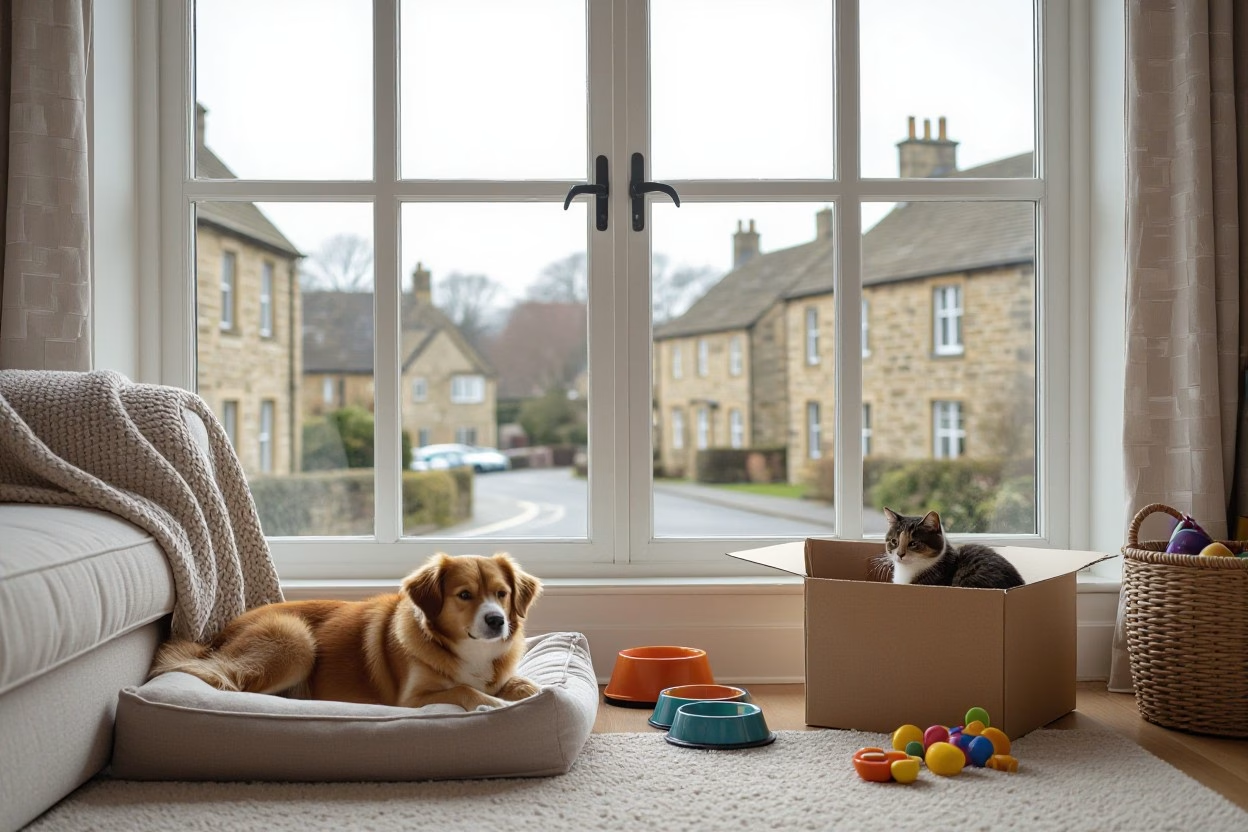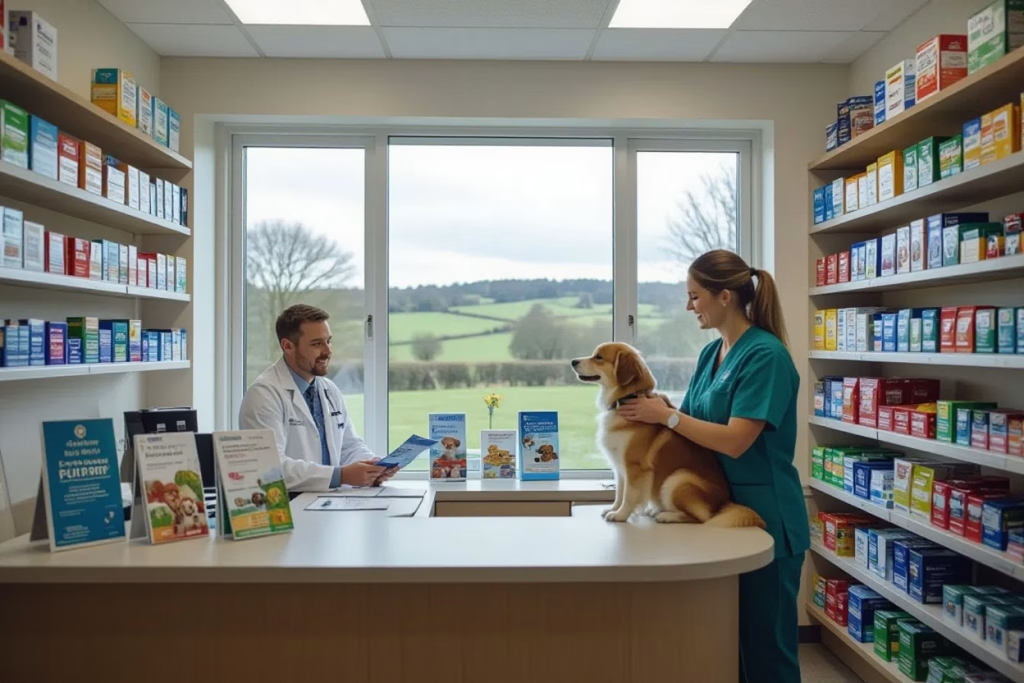Pets face relocation stress that can trigger health risks and behavioural change, so as you move to Harrogate or Wetherby you should follow clear steps to help your animal settle. Focus on gradual introductions, secure fencing in the countryside (escape risk) or enrichment in town, and arrange to register with a local vet (Register Your Pet) and plan follow‑ups (Consultations, Pet Wellness Plan) to protect your pet’s wellbeing.
The Psychological Toll of Relocation on Pets
Many pets react to moving with heightened stress and anxiety, showing changes in appetite, sleep and social behaviour that can last from a few days to several weeks. You may notice regression in housetraining, increased vocalisation or clinginess, and sometimes gastrointestinal upset; studies and clinical experience suggest most animals begin to adjust within 2–6 weeks, though seniors and those with prior trauma can take longer.
Recognizing Signs of Stress in Your Pets
Pacing, hiding, loss of appetite, diarrhoea, excessive grooming or sudden aggression are common indicators you should watch for; cats often stop using the litter tray while dogs may persistent pawing at doors or destructive chewing. Severe signs such as collapse, continuous vomiting, blood in stool, or unprovoked aggression require immediate veterinary attention — seek help if these occur within 24 hours.
Factors That Contribute to Anxiety During a Move
Major contributors include abrupt routine change, removal from familiar territory, prolonged car travel, exposure to unfamiliar animals or loud noises, and the pet’s age or prior experiences; herding and working breeds often show stronger territorial stress. Short-term separation from you during viewings or removals can intensify fear in social breeds.
- Routine change
- Territory loss
- Car travel
- Noise and new animals
Knowing which of these factors affects your pet most helps you prioritise calming strategies and veterinary advice.
Older pets commonly show increased confusion and separation behaviours, while puppies and kittens may adapt faster but can form fear responses if overwhelmed; you can reduce risk by introducing the carrier, short car trips under 30–60 minutes, and staged exposure to new rooms over several days. Behavioural medications or pheromone therapies are effective in many cases — discuss options with your vet before the move to create a tailored plan.
- Senior pets
- Puppies and kittens
- Short acclimatisation trips
- Veterinary behaviour support
Knowing which interventions match your pet’s profile speeds recovery and reduces long-term anxiety.

Strategies to Help Your Pets Adjust to a New Environment
Creating a Safe Space in Your New Home
Place a dedicated room or corner with your pet’s bed, toys, and two familiar-smelling items from the old home; offer at least one hiding spot per pet and keep food/water on the original schedule within 15 minutes of usual times. Use pheromone diffusers like Adaptil or Feliway, lock away toxic plants and human foods, and limit visitors for the first 48–72 hours to reduce stress and prevent escape attempts.
Gradual Exploration of Surroundings
Start with supervised access to the garden or one quiet room for 3–5 days, then introduce short on-lead walks of 5–10 minutes on quieter streets before busy routes; for cats use a harness or carrier for outings and for small mammals use secure runs. Watch for signs like pacing, excessive grooming, or hiding, and avoid areas with heavy traffic or livestock until your pet is confident.
Map a two-week plan: days 1–3 keep exploration indoors and in the garden, days 4–7 add two brief on-lead outings to calm, low-traffic streets, and week 2 extend walks to 20–30 minutes and visit one green space — in Harrogate try The Stray, in Wetherby focus on quieter riverside paths. Carry familiar bedding and high-value treats, mark progress in a simple log (time out, behaviour, triggers) and increase exposure by no more than 50% per day. If you see persistent panting, trembling, loss of appetite or aggression, book a consultation via https://yfvets.co.uk/consultations/ or register your pet at https://yfvets.co.uk/register-your-pet/ for tailored advice.

Navigating the Unique Pet Landscape of Harrogate and Wetherby
Harrogate offers expansive municipal green space like The Stray (around 200 acres) and RHS Harlow Carr, higher footfall in summer and more urban veterinary/grooming options; Wetherby gives you riverside walking on the River Wharfe and immediate access to farmland and bridleways, which means more off‑lead potential but increased exposure to ticks and livestock. You should plan for seasonal visitor spikes (May–Sept), local on‑lead bylaws, and road risks near busy junctions when choosing routes and daily routines.
Comparing Pet-Friendly Amenities: Countryside vs. Town
Countryside areas around Wetherby give you wide off‑lead fields, farm tracks and quieter nights but fewer 24/7 pet services; Harrogate town supplies multiple vets, groomers and pet stores within a few miles plus structured green areas for socialisation. If you rely on fast access to emergency care or frequent grooming, town living reduces travel time; if your priority is space and countryside walks, accept longer journeys to clinics and occasional livestock encounters.
Countryside vs Town — Amenities at a glance
| Countryside | Town |
|---|---|
| Space: wide fields, bridleways; ideal for exercise | Space: parks/Stray, defined paths; easier socialisation |
| On‑lead rules: more livestock → on‑lead near sheep | On‑lead rules: more bylaws and busy streets |
| Vets/Groomers: fewer, longer drives | Vets/Groomers: multiple options, faster access |
| Hazards: ticks, firearms/shot seasons, farm traffic | Hazards: busy roads, crowded summer footfall |
| Transport: limited public transport; parking needed | Transport: better buses, short drives to services |
Access to Green Spaces and Walking Trails
Harrogate gives you circular routes from 1–4 miles on The Stray and formal gardens like Harlow Carr, plus gateway walks into Nidderdale and the Dales for 5–12 mile hikes; Wetherby’s riverside paths typically run 2–6 miles along the Wharfe and connect to farm tracks. Expect tick activity March–October, muddy winter trails, and seasonal livestock signs requiring you to keep dogs controlled near fields.
Map resources such as Ordnance Survey and local parish maps list permissive paths and bridleways; sample local walks include a 2–3 mile Harlow Carr loop and a 4–5 mile Wetherby riverside + towpath circuit. Carry water, a tick remover, and waterproof footwear for your dog if you plan longer routes; if you spot livestock, close gates and put your dog on a lead. For post‑walk checks or parasite advice book a consultation with your local practice.
Essential Steps for Finding the Right Local Vet
Start by mapping practices within a 10–15 minute drive from your new address, check weekday and weekend opening hours, and confirm their out-of-hours emergency arrangements. Visit two clinics to assess cleanliness, nurse availability, and how quickly you can get same-day appointments. Scan online reviews and ask neighbours about experiences with surgery communication, waiting times, and fees to form a shortlist before registering your pet.
What to Consider When Choosing a Veterinary Clinic
Verify that the practice is RCVS-accredited, ask whether they have on-site dental, surgical and diagnostic imaging, and find out if nurses run dedicated wellness and behaviour clinics. Compare preventative care offers—many local vets provide monthly parasite plans or a Pet Wellness Plan to spread costs. Confirm referral links for complex cases and which nearby hospitals cover 24/7 emergencies so you know where your pet would go after-hours.
Importance of Registering with a Local Vet
Registering quickly secures your pet a medical record at the practice, gives you access to booked consultations, and ensures your vaccination and microchip details transfer properly; use the practice’s online form at Register Your Pet to speed the process and avoid delays when you need care.
Once registered the practice builds a complete medical history, schedules boosters and parasite control, and can tailor a preventive plan for senior pets or high-risk breeds. Bring previous records, current medication lists, and the microchip number to your first visit. Many clinics require registration before routine procedures and will enrol you in reminders or a Pet Wellness Plan (details) and offer online booking for consultations (consultations), which speeds access when time-sensitive issues arise.
Preparing for the Transition: Health and Care Essentials
Updating Vaccinations and Health Records
Check your pet’s vaccine timetable against UK guidance: dogs require core shots (distemper, parvovirus, hepatitis) at 8, 12 and 16 weeks with a 12‑month booster and annual leptospirosis plus 1–3 yearly boosters depending on vaccine; cats need FHV, calicivirus and panleukopenia on a similar schedule. Update your microchip contact details and transfer records to your new practice via Register Your Pet. Keep both printed and digital copies for the first 30 days.
Planning for Routine Care and Emergencies
Map local practices within a 10–15 minute drive, save two vet contacts and an out‑of‑hours number, and register online to speed care. Assemble a first‑aid kit, a 7‑day medication supply, a tick remover and practise monthly parasite prevention—especially May–September when ticks peak. Keep your carrier, harness and insurer details accessible and add your vet’s number to your phone’s ICE contact.
Create an emergency folder containing your pet’s vaccination certificate, current medication list with dosages, microchip number and insurance policy; store copies on your phone and fridge. Identify the nearest 24/7 emergency clinic and pre‑programme its route. Run short daily carrier sessions (5 minutes), keep a 2–4 day food/medicine stash, and have a tick/removal tool ready for immediate action after walks.
Summing up
Presently, as you relocate to Harrogate or Wetherby with pets, follow clear steps to protect their health: register your pet with a local vet, book an initial consultation, and enrol in a wellness plan to ensure preventive care; adapt routines to countryside versus town life, secure microchipping and up-to-date vaccinations, and monitor behaviour and appetite so you can address problems early with professional support.
FAQ
Q: What signs indicate my pet is stressed by the move and how long might it last?
A: Look for changes in appetite, hiding, increased vocalisation, toileting indoors, pacing, over-grooming or aggression. Dogs may show clinginess or avoidance; cats may hide for days to weeks. Most pets start to settle within 1–3 weeks with steady routines; some anxious or older animals can take longer and may benefit from behavioural support or a vet consultation if symptoms persist. If you’re concerned, book a check-up: Consultations.
Q: How can I help my dog or cat settle quickly into a new Harrogate or Wetherby home?
A: Start by setting up a dedicated quiet room with familiar bedding, toys and litter tray or feeding station. Maintain regular feeding, walking and play schedules. Use familiar scents (unwashed blankets), provide hiding spots for cats and short supervised exploration of the rest of the house. For dogs, keep walks calm, gradually increase new routes and social contact, and introduce the garden slowly. Consider pheromone diffusers, short training sessions to build confidence, and a post-move wellness check with your vet.
Q: What local factors in Harrogate and Wetherby should I consider for pet safety and exercise?
A: Countryside areas offer fields, bridleways and more space but also livestock, gamebirds and ticks; keep dogs under control near livestock and use tick prevention. Town centres have more traffic, pavements, cafés and small parks — watch for busy roads, cyclists and unfamiliar dogs. Check local footpaths and rights of way for safe off-lead exercise, and be aware of seasonal issues like sheep worrying fines or lambing seasons. Plan where you’ll exercise your pet and adjust lead use, parasite prevention and supervision accordingly.
Q: How do I register with a local vet after moving and what should I arrange first?
A: Register online via Register Your Pet. After registering, book an initial consultation to update medical records, confirm vaccinations, review parasite control and update microchip/contact details. Ask about a tailored Pet Wellness Plan to spread routine care costs and get preventive care scheduled: Pet Wellness Plan. Keep emergency contact details handy for local out-of-hours care.
Q: What should I do about travel safety and short trips around Harrogate or Wetherby?
A: Use a secure crate or a vehicle harness fitted to seatbelts for car journeys; acclimatise pets with short practice drives before longer trips. Bring water, a small bowl, familiar toys and a travel first-aid kit. For anxious pets, discuss calming strategies or medication with your vet prior to travel: Consultations. Ensure ID tags and microchip addresses are updated so you can be contacted quickly if your pet gets lost.

